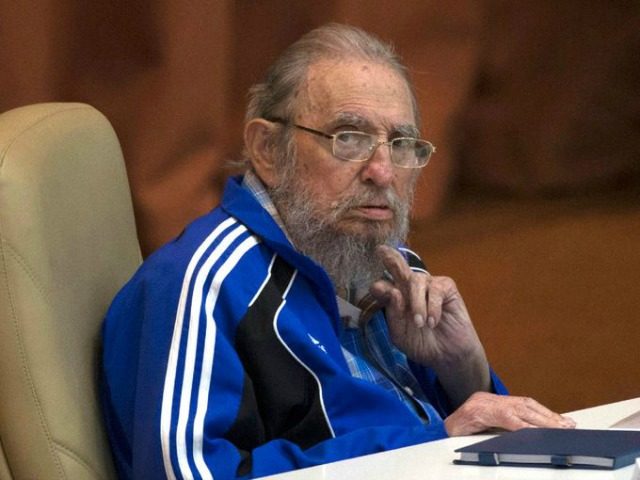As Cuba continues to endure a mandatory nine-day mourning period for its late dictator Fidel Castro, the nation’s Santeria priests (babalawos) have once again begun to speculate about decades-old rumors that Castro practiced their African religion and to warn that Castro’s spirit may still haunt the island.
One babalawo told the Spain-based Diario de Cuba that he fears Castro may continue to plague the island as a ghost. “That spirit is wandering around and good luck to whoever it possesses,” says babalawo Obbara Meyi, advising, according to the newspaper, that his religious community “cover their heads when they go out in public” to prevent Castro from possessing them.
Santería is a Caribbean, largely Cuban, religion based in the Nigerian Yoruba faith. Due to exposure to Catholicism through its Spanish population, santeros, as adherents are known, worship both African gods and Catholic saints, as well as the Virgin Mary, Jesus, and the Holy Spirit. Cuba’s patron saint, the Virgin Mary of Charity, is often worshipped as her African analog Ochún.
Other santero priests believe that Castro was made santo – his spirit trusted to an orisha, or African god – for Oddua, the first god-king of the earth, and a god the Yoruba religion associates with the dead. As Cuban Santería ascribes a Catholic counterpart to all the Yoruba gods, Oddua is associated with Jesus Christ.
“Oddua is so strong that he is the boss of the dead, and that’s how he kept us all, living dead,” one priestess tells the Diario. Martí news, citing the Diario, notes that the Oddua speculation is the product of rumors that Castro was initiated as a santo in an African ceremony that included elephants, typically associated with that god.
While Castro was nominally a communist and, thus, an atheist, the speculation regarding his ties to Santería began the day he took power. As a 2004 Miami Herald article explains, January 1 – the day Castro took over Cuba in 1959 – is a day typically associated with Elegua, the god of “crossroads.” Castro’s 26 of July Marxist movement entered the center of Havana waving red and black flags, colors associated with Marxism in the West, but known as the colors of Elegua to santeros.
The article goes on to note that, while Santería, like all religions, suffered a crackdown under Castro, the dictator invited King Sijuwade Otubuse II, head of Yoruba faith, to visit the island in 1980, likely as a way to appease the nation’s Afro-Cuban population, whose standard of living had not improved as the Revolution promised. Priests speaking to the Diario de Cuba this week note, however, that Cuba’s State Security closely monitored every spell suspect babalawos cast, hoping to prevent them from casting any curses on the dictator.
Since then, numerous Santería priests have come forward claiming to have made potions and cast spells on Castro’s behalf. A babalawo identified as “José” tells the Sun Sentinel in 1992 that he had been “consulted by top officers in the armed forces” and helped a member of the Castro family. The article notes that the government provided Santería preferential treatment over other religions because “many santeros are influential members of Cuban society,” and estimated that 62 percent of Cubans in Havana practiced Santería.
In 2008, when Castro stepped down, babalawos were openly telling foreign media outlets that they were engaging in witchcraft on Castro’s behalf. “Olodumare says he is the one that should be there and so he is untouchable,” a babalawo tells Reuters. Cuba was also openly employing Santería in its cultural imperialism campaign over neighboring Venezuela. Following the announcement that late dictator Hugo Chávez had been diagnosed with cancer, Cuba’s babalawos openly pleaded to Chávez to turn to them for spells they claimed could save his life.
“I hope, God willing, that he decides to knock on the door of a Cuban priest and that God will allow for the possibility of this individual to do something for him,” Lazaro Cuesta, a communist-approved babalawo, informs the Associated Press.
While Castro never admitted in life to practicing Santería, though many witnesses during his half-century reign of terror have claimed his did, the facts surrounding his funeral have perplexed some babalawos. The Diario de Cuba notes that cremation is prohibited for santeros, leading many to believe the urn allegedly carrying Castro’s ashes is a fraud. One santero identified only as a “son of Elegua” in the article speculates that the urn is a ruse intended to keep santeros from stealing Castro’s bones and using them to cast spells. “Can you imagine the power that one could attain by stealing one of those bones?” he asks. “You can do some tremendous witchcraft even with the ashes.”
Dictator Raúl Castro announced his elder brother Fidel’s death on Friday at the age of 90. The government has banned alcohol sales, any incident described as a “public spectacle,” loud music, or loud laughter for nine days. Anyone insufficiently mournful in public is a risk of running afoul of the state and landing in prison, and employers are expected to intimidate their workers into attending hours-long public acts to commemorate the dictator.

COMMENTS
Please let us know if you're having issues with commenting.